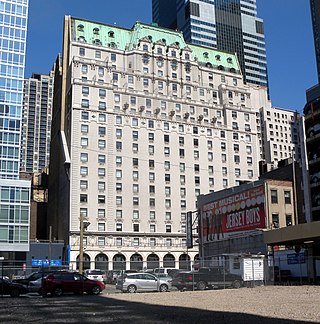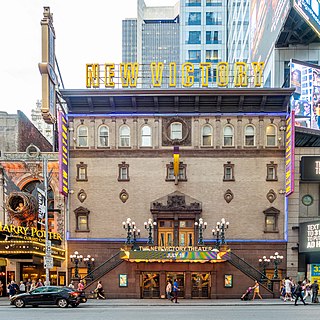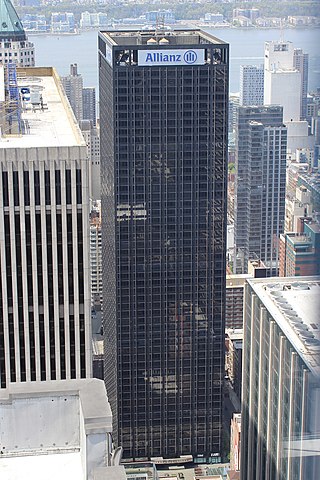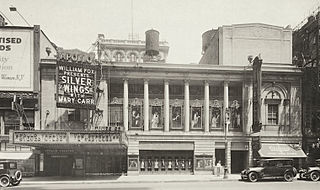
Billy Rose was an American impresario, theatrical showman, lyricist and columnist. For years both before and after World War II, Billy Rose was a major force in entertainment, with shows such as Billy Rose's Crazy Quilt (1931), Jumbo (1935), Billy Rose's Aquacade (1937), and Carmen Jones (1943). As a lyricist, he is credited with many songs, notably "Don't Bring Lulu" (1925), "Tonight You Belong To Me" (1926), "Me and My Shadow" (1927), "More Than You Know" (1929), "Without a Song" (1929), "It Happened in Monterrey" (1930), and "It's Only a Paper Moon" (1933).

The Palace Theatre is a Broadway theater at 1564 Broadway, facing Times Square, in the Midtown Manhattan neighborhood of New York City. Designed by Milwaukee architects Kirchhoff & Rose, the theater was funded by Martin Beck and opened in 1913. From its opening to about 1929, the Palace was considered among vaudeville performers as the flagship of Benjamin Franklin Keith and Edward Franklin Albee II's organization. The theater had 1,743 seats across three levels as of 2018.

The Ed Sullivan Theater is a theater at 1697–1699 Broadway, between 53rd and 54th Streets, in the Theater District of Midtown Manhattan in New York City. Built from 1926 to 1927 as a Broadway theater, the Sullivan was developed by Arthur Hammerstein in memory of his father, Oscar Hammerstein I. The two-level theater was designed by Herbert J. Krapp with over 1,500 seats, though the modern Ed Sullivan Theater was downsized to 370 seats by 2015. The neo-Gothic interior is a New York City landmark, and the building is on the National Register of Historic Places.

The Nederlander Theatre is a Broadway theater at 208 West 41st Street in the Theater District of Midtown Manhattan in New York City. Opened in 1921, it was designed by William Neil Smith for theatrical operator Walter C. Jordan. It has around 1,235 seats across two levels and is operated by the Nederlander Organization. Since 1980, it has been named for American theater impresario David Tobias Nederlander, father of theatrical producer James M. Nederlander. It is the southernmost Broadway theater in the Theater District.
Beatrice Kay was an American singer, vaudevillian, music hall performer, and stage and film actress.

The Paramount Theatre was a 3,664-seat movie palace located at 43rd Street and Broadway on Times Square in Midtown Manhattan, New York City. Opened in 1926, it was a showcase theatre and the New York headquarters of Paramount Pictures. Adolph Zukor, founder of Paramount predecessor Famous Players Film Company, maintained an office in the building until his death in 1976. The Paramount Theatre eventually became a popular live performance venue. The theater was closed in 1964 and its space converted to office and retail use. The tower which housed it, known as the Paramount Building at 1501 Broadway, is in commercial use as an office building and is still home to Paramount Pictures offices.

The James M. Nederlander Theatre is a theater located at 24 West Randolph Street in the Loop area of downtown Chicago, Illinois. Previously known as the Oriental Theatre, it opened in 1926 as a deluxe movie palace and vaudeville venue. Today the Nederlander presents live Broadway theater and is operated by Broadway In Chicago, currently seating 2,253.

The Paramount Hotel is a hotel in the Theater District of Midtown Manhattan in New York City, United States. Designed by architect Thomas W. Lamb, the hotel is at 235 West 46th Street, between Eighth Avenue and Broadway. The Paramount Hotel is owned by RFR Realty and contains 597 rooms. The hotel building, designed in a Renaissance style, is a New York City designated landmark.

Saenger Theatre is an atmospheric theatre in downtown New Orleans, Louisiana, which is on the National Register of Historic Places. Once the flagship of Julian and Abe Saenger's theatre empire, today it is one of only a handful of Saenger movie palaces that remain.

The Somerville Theatre is an independent movie theater and concert venue in the Davis Square neighborhood of Somerville, Massachusetts, United States. Over one hundred years old, the Somerville Theatre started off as a vaudeville house and movie theater. The theater has since transitioned and now operates as a live music venue and first-run movie theater. As a music venue, the theater has played host to many historic concerts, including the first of the two Last Dispatch concerts, two shows by Bruce Springsteen in 2003, and a performance by U2 in 2009. Recent live performances have included Ryan Adams & the Cardinals, Cursive, Norah Jones, The Jonas Brothers, Joan Baez, and the John Butler Trio.

The New Victory Theater is a theater at 209 West 42nd Street in the Theater District of Midtown Manhattan in New York City, near Times Square. Built in 1900 as the Republic Theatre, it was designed by Albert Westover and developed by Oscar Hammerstein I as a Broadway theater. The theater has been known by several names over the years, including the Belasco Theatre, Minsky's Burlesque, and the Victory Theatre. The theater is owned by the city and state governments of New York and leased to nonprofit New 42, which has operated the venue as a children's theater since 1995. The New Victory presents theater shows, dance shows, puppet shows, and other types of performance art shows from all around the world.

An atmospheric theatre is a type of movie palace design which was popular in the late 1920s. Atmospheric theatres were designed and decorated to evoke the feeling of a particular time and place for patrons, through the use of projectors, architectural elements and ornamentation that evoked a sense of being outdoors. This was intended to make the patron a more active participant in the setting.

The Hudson Theatre is a Broadway theater at 139–141 West 44th Street, between Seventh Avenue and Sixth Avenue, in the Theater District of Midtown Manhattan in New York City. One of the oldest surviving Broadway venues, the Hudson was built from 1902 to 1903. The exterior was designed by J. B. McElfatrick & Son, while Israels & Harder oversaw the completion of the interior. The theater has 970 seats across three levels. Both its exterior and interior are New York City designated landmarks, and the theater is on the National Register of Historic Places.

Paramount Plaza, also 1633 Broadway and formerly the Uris Building, is a 48-story skyscraper in the Midtown Manhattan neighborhood of New York City. Designed by Emery Roth and Sons, the building was developed by the Uris brothers and was renamed for its owner, the Paramount Group, by 1980. Paramount Plaza occupies a site bounded by Broadway to the east, 51st Street to the north, and 50th Street to the south.

The 44th Street Theatre was a Broadway theater at 216 West 44th Street in the Theater District of Manhattan in New York City from 1912 to 1945. It was originally named Weber and Fields' Music Hall when it opened in November 1912 as a resident venue for the comedy duo Weber and Fields, but was renamed to the 44th Street Theatre in December 1913 after their tenure at the theatre ended. It should not be confused with the Weber and Fields' Broadway Music Hall, often referred to as simply Weber and Fields' Music Hall and also known as Weber's Music Hall or Weber's Theatre, which was used by both Weber and Fields or just Weber from 1896 through 1912.

The Gaiety Theatre was a Broadway theatre at 1547 Broadway in Times Square, Manhattan, New York City from 1909 until 1982, when it was torn down.
Randy Weiner is an American playwright, producer and theater and nightclub owner. Weiner co-wrote the Off-Broadway musical The Donkey Show and, as one-third of EMURSIVE, produced the Drama Desk Award winning New York premiere of Punchdrunk's Sleep No More. He is co-owner of NYC "theater of varieties" The Box and The Box Soho. His latest creation The Stranger is a Time Out New York 2023 "Best of the City" award winner.

1501 Broadway, also known as the Paramount Building, is a 33-story office building on Times Square between West 43rd and 44th Streets in the Theater District neighborhood of Manhattan in New York City. Designed by Rapp and Rapp, it was erected from 1925 to 1927 as the headquarters of Paramount Pictures. The building is designed in the Art Deco and Beaux-Arts styles. The office wing on Times Square contains numerous setbacks as mandated by the 1916 Zoning Resolution, while the rear wing housed the Paramount Theatre from 1926 to 1967. Newmark & Company owns 1501 Broadway.

The Apollo Theatre was a Broadway theatre whose entrance was located at 223 West 42nd Street in Manhattan, New York City, while the theatre proper was on 43rd Street. It was demolished in 1996 and provided part of the site for the new Ford Center for the Performing Arts, now known as the Lyric Theatre.

Olympic Theatre was the name of five former 19th and early 20th-century theatres on Broadway in Manhattan and in Brooklyn, New York.





















